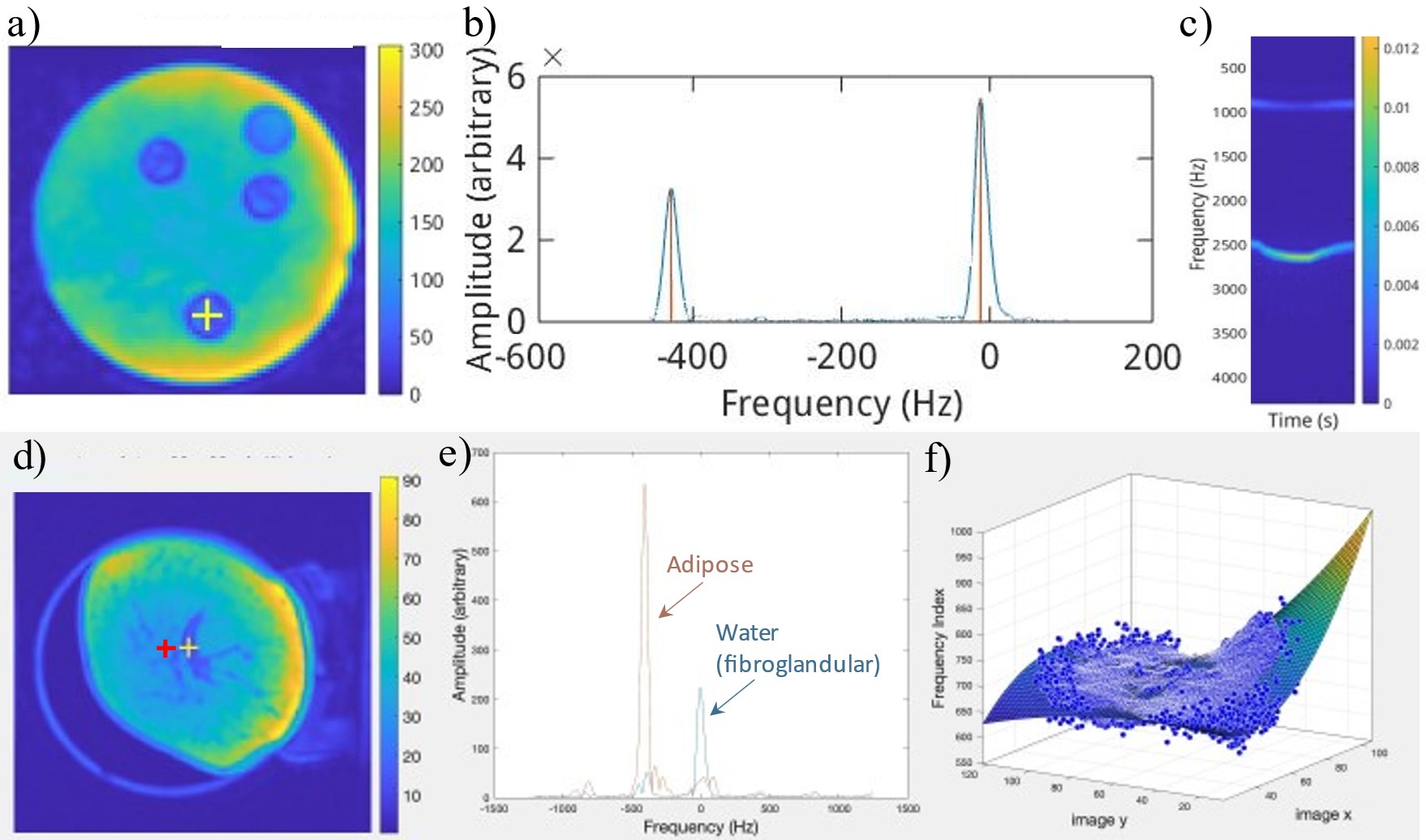Spencer Fox Eccles School of Medicine
53 Absolute MR Thermometry in the breast using interleaved echo planar spectroscopic imaging
Peyton Wong; Henrik Odéen; Duane Blatter; Seong-Eun Kim; Allison Payne; and Dennis L. Parker
Faculty Mentor: Henrik Odéen (Radiology & Imaging Sciences, University of Utah)
Introduction
Many MR parameters with temperature dependence have been investigated for thermal monitoring during treatments.1 Most of these approaches can only measure change in temperature. However, spectroscopic approaches have been shown to be able to measure absolute temperature changes by comparing temperature sensitive and temperature insensitive proton pools. This has been demonstrated for water and fat in the breast and for water and N-acetylaspartate (NAA) in the brain. 2–6
Methods
A multi-echo interleaved echo planar spectroscopic imaging (iEPSI) pulse sequence was modified to allow acquisition of up to 32 mono- or bi-polar echoes and interleaving of multiple sets of those echoes to effectively achieve a smaller echo spacing. Other parameters were altered to minimize artifacts, yield effective FID measurements, and trade-off spectral resolution and coverage. Experiments were performed in ex vivo breast fat samples and in a healthy volunteer. The breast fat samples were cooled and heated between 3-35°C in a water bath setup. All experiments were performed at 3T and data were processed using custom Matlab scripts. To convert frequency difference to temperature a direct relationship following

is assumed. Without knowing the absolute temperature relationship, it was assumed there is a frequency difference, ∆𝑓o, at which the temperature is 𝑇o.
Results
Fig.1 shows spectra from a single voxel using single voxel spectroscopy (SVS) (10 mm3 voxel) in the ex vivo breast fat sample. Spectra from the described iEPSI pulse sequence (1.5×1.5×2 mm3 voxel) were also obtained, indicating that the fat and water peaks can be detected using both approaches. Fig.1 also shows in vivo feasibility in a healthy volunteer. Both fat and water peaks can be detected in both fibroglandular and adipose tissue. The detected frequency spacing can be extrapolated across the full breast demonstrating the spatial monitoring potential of the iEPSI technique.
Discussion and Conclusions
An efficient approach to acquire high-resolution spectroscopic images using an interleaved echo-planar imaging-type pulse sequence has been developed and evaluated for absolute temperature measurements in ex vivo breast fat samples and a healthy volunteer. To improve quality of iEPSI spectra more advanced peak-finding algorithms, filtering methods, and averaging could be performed. It is hypothesized that in vivo absolute temperature measurements will contribute to more accurate treatment monitoring and evaluation by providing accurate starting temperatures for thermal dose calculations.

Footnotes
- Odéen H, Parker DL. Magnetic resonance thermometry and its biological applications – Physical principles and practical considerations. Prog Nucl Magn Reson Spectrosc. 2019;110:34-61. doi:10.1016/j.pnmrs.2019.01.003
- McDannold N, Barnes AS, Rybicki FJ, et al. Temperature mapping considerations in the breast with line scan echo planar spectroscopic imaging. Magn Reson Med. 2007;58(6):1117-1123. doi:10.1002/mrm.21322
- Corbett R, Laptook A, Weatherall P. Noninvasive Measurements of Human Brain Temperature Using Volume-Localized Proton Magnetic Resonance Spectroscopy. Journal of Cerebral Blood Flow & Metabolism. 1997;17(4):363-369. doi:10.1097/00004647-199704000-00001
- Weis J, Covaciu L, Rubertsson S, Allers M, Lunderquist A, Ahlström H. Noninvasive monitoring of brain temperature during mild hypothermia. Magn Reson Imaging. 2009;27(7):923-932. doi:10.1016/J.MRI.2009.01.011
- Covaciu L, Rubertsson S, Ortiz-Nieto F, Ahlström H, Weis J. Human brain MR spectroscopy thermometry using metabolite aqueous-solution calibrations. J Magn Reson Imaging. 2010;31(4):807-814. doi:10.1002/JMRI.22107
- Dehkharghani S, Mao H, Howell L, et al. Proton resonance frequency chemical shift thermometry: Experimental design and validation toward high-resolution noninvasive temperature monitoring and in vivo experience in a nonhuman primate model of acute ischemic stroke. American Journal of Neuroradiology. 2015;36(6):1128-1135. doi:10.3174/ajnr.A4241
Media Attributions
- Equation
- 137489262_range_figure

